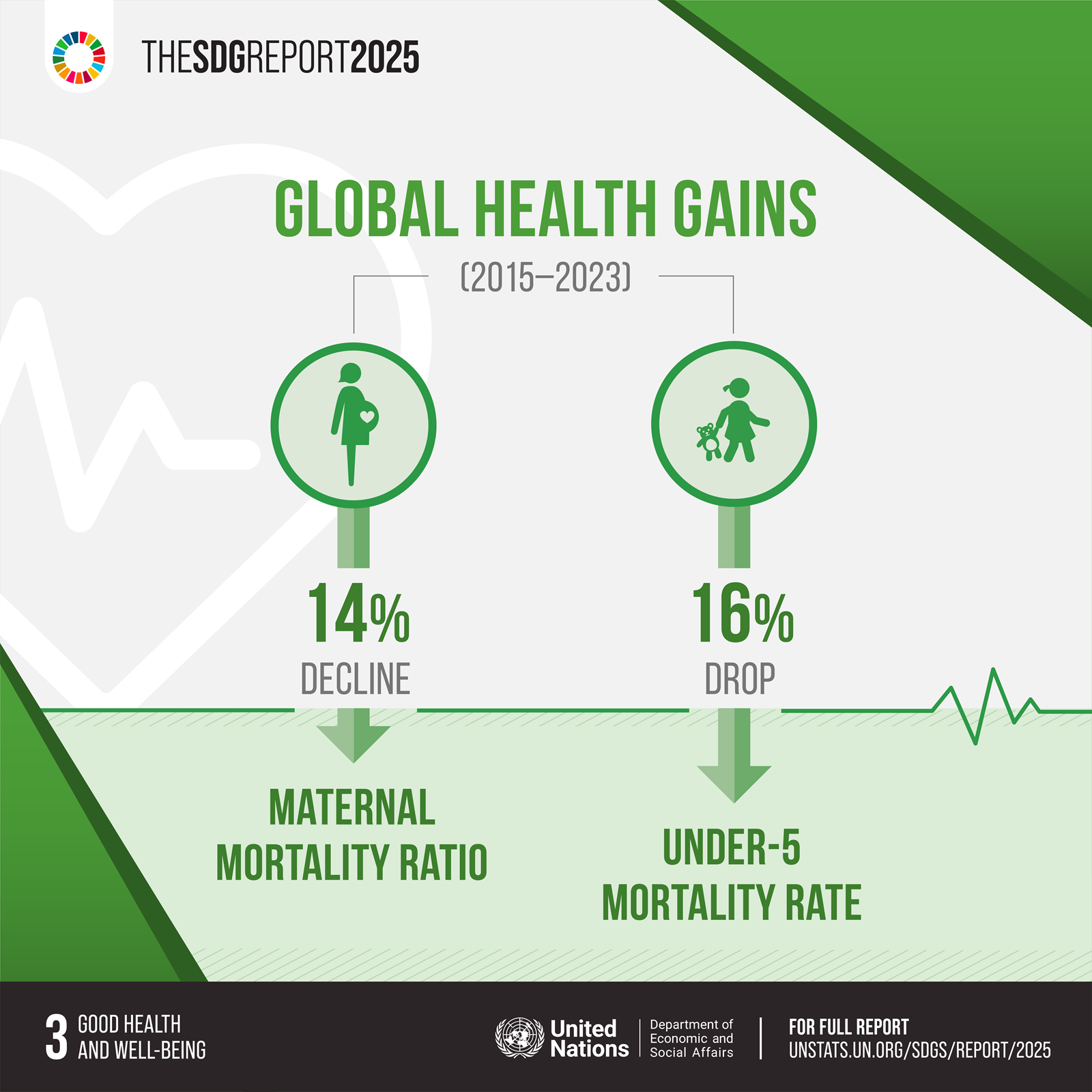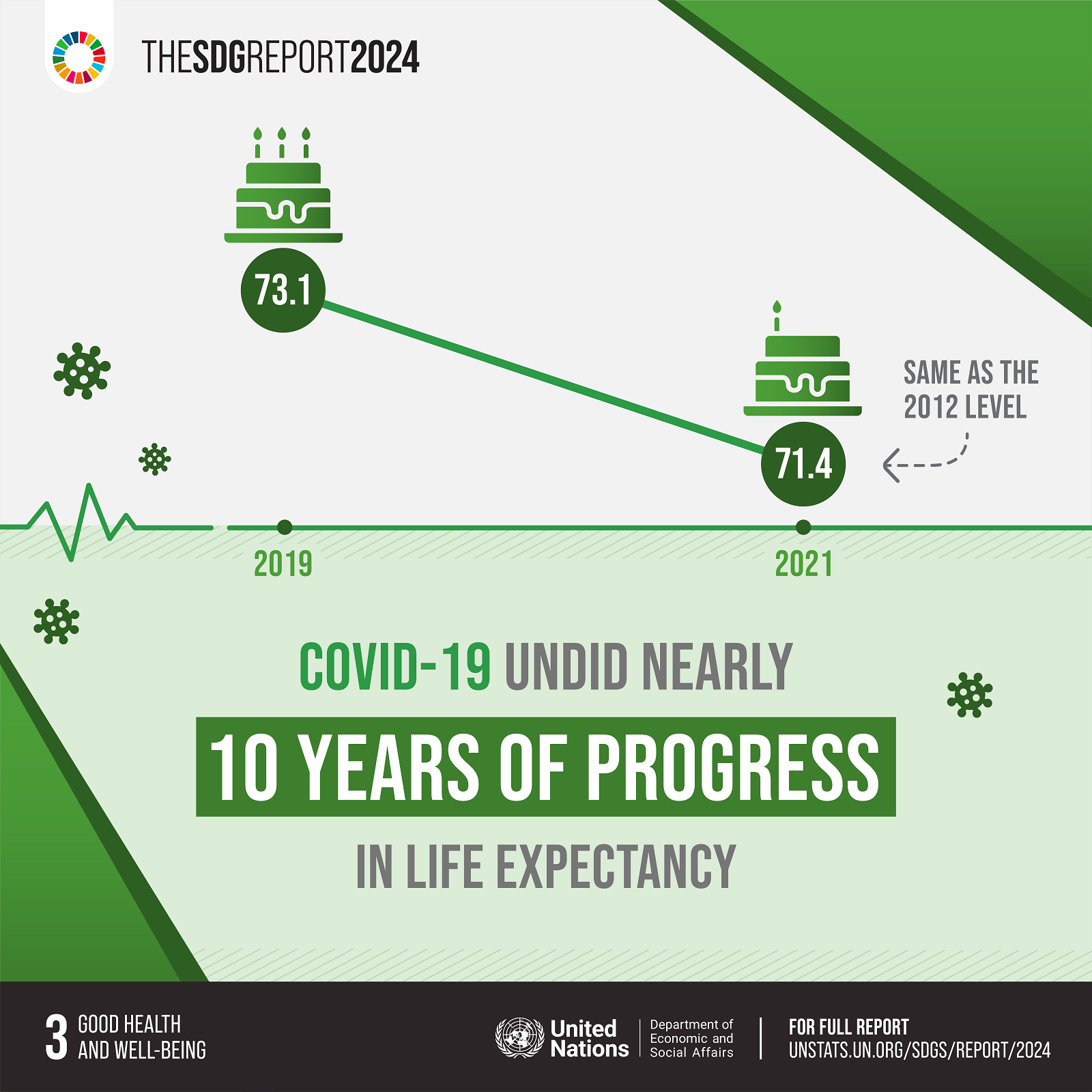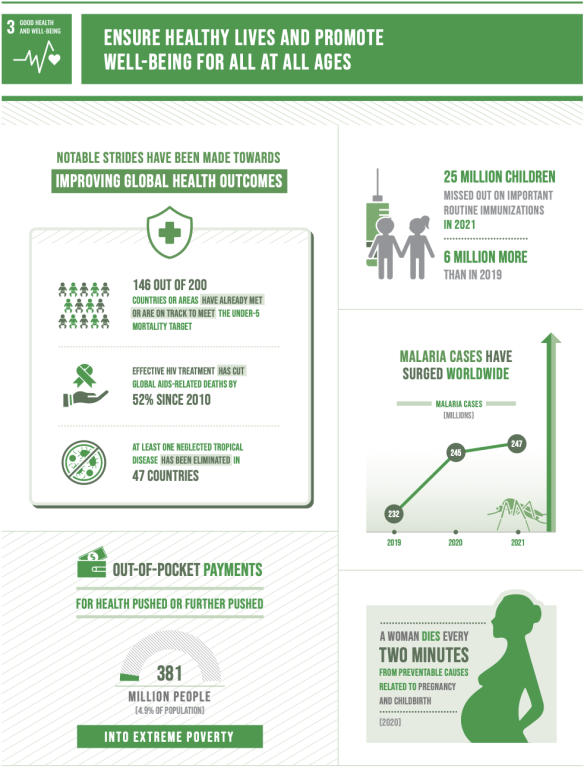
Health and population

Sustainable transport
Targets and Indicators

3.1
By 2030, reduce the global maternal mortality ratio to less than 70 per 100,000 live births
3.1.1
Maternal mortality ratio
3.1.2
Proportion of births attended by skilled health personnel

3.2
By 2030, end preventable deaths of newborns and children under 5 years of age, with all countries aiming to reduce neonatal mortality to at least as low as 12 per 1,000 live births and under-5 mortality to at least as low as 25 per 1,000 live births
3.2.1
Under-five mortality rate
3.2.2
Neonatal mortality rate

3.3
By 2030, end the epidemics of AIDS, tuberculosis, malaria and neglected tropical diseases and combat hepatitis, water-borne diseases and other communicable diseases
3.3.1
Number of new HIV infections per 1,000 uninfected population, by sex, age and key populations
3.3.2
Tuberculosis incidence per 100,000 population
3.3.3
Malaria incidence per 1,000 population
3.3.4
Hepatitis B incidence per 100,000 population
3.3.5
Number of people requiring interventions against neglected tropical diseases

3.4
By 2030, reduce by one third premature mortality from non-communicable diseases through prevention and treatment and promote mental health and well-being
3.4.1
Mortality rate attributed to cardiovascular disease, cancer, diabetes or chronic respiratory disease
3.4.2
Suicide mortality rate

3.5
Strengthen the prevention and treatment of substance abuse, including narcotic drug abuse and harmful use of alcohol
3.5.1
Coverage of treatment interventions (pharmacological, psychosocial and rehabilitation and aftercare services) for substance use disorders
3.5.2
Alcohol per capita consumption (aged 15 years and older) within a calendar year in litres of pure alcohol

3.6
By 2020, halve the number of global deaths and injuries from road traffic accidents
3.6.1
Death rate due to road traffic injuries

3.7
By 2030, ensure universal access to sexual and reproductive health-care services, including for family planning, information and education, and the integration of reproductive health into national strategies and programmes
3.7.1
Proportion of women of reproductive age (aged 15-49 years) who have their need for family planning satisfied with modern methods
3.7.2
Adolescent birth rate (aged 10-14 years; aged 15-19 years) per 1,000 women in that age group

3.8
Achieve universal health coverage, including financial risk protection, access to quality essential health-care services and access to safe, effective, quality and affordable essential medicines and vaccines for all
3.8.1
Coverage of essential health services
3.8.2
Proportion of population with large household expenditures on health as a share of total household expenditure or income

3.9
By 2030, substantially reduce the number of deaths and illnesses from hazardous chemicals and air, water and soil pollution and contamination
3.9.1
Mortality rate attributed to household and ambient air pollution
3.9.2
Mortality rate attributed to unsafe water, unsafe sanitation and lack of hygiene (exposure to unsafe Water, Sanitation and Hygiene for All (WASH) services)
3.9.3
Mortality rate attributed to unintentional poisoning

3.a
Strengthen the implementation of the World Health Organization Framework Convention on Tobacco Control in all countries, as appropriate
3.a.1
Age-standardized prevalence of current tobacco use among persons aged 15 years and older

3.b
Support the research and development of vaccines and medicines for the communicable and non-communicable diseases that primarily affect developing countries, provide access to affordable essential medicines and vaccines, in accordance with the Doha Declaration on the TRIPS Agreement and Public Health, which affirms the right of developing countries to use to the full the provisions in the Agreement on Trade-Related Aspects of Intellectual Property Rights regarding flexibilities to protect public health, and, in particular, provide access to medicines for all
3.b.1
Proportion of the target population covered by all vaccines included in their national programme
3.b.2
3.b.3
Health product access index

3.c
Substantially increase health financing and the recruitment, development, training and retention of the health workforce in developing countries, especially in least developed countries and small island developing States
3.c.1
Health worker density and distribution

3.d
Strengthen the capacity of all countries, in particular developing countries, for early warning, risk reduction and management of national and global health risks
3.d.1
International Health Regulations (IHR) capacity and health emergency preparedness
3.d.2
Percentage of bloodstream infections due to selected antimicrobial-resistant organisms
Progress and Info
The latest data show mixed results across health indicators. While maternal mortality has declined, the pace of improvement falls far short of what is needed to meet the targets for 2030. Under-5 and neonatal mortality rates have improved significantly since 2000, offering the potential to save millions more lives if progress accelerates. HIV-related deaths have halved since 2010, but millions of people still lack treatment, and global positive trends hide data showing that rates of new infections are rising in several regions. Neglected tropical diseases affect nearly 1.5 billion people globally. Achieving universal health coverage requires intensified commitment to reach those who are the furthest behind. The United Nations is advancing universal health coverage and promoting equitable, people-centred health systems, focusing on fragile, conflict-affected regions and areas with significant health inequalities. Through such initiatives as the Joint United Nations Programme on HIV/AIDS (UNAIDS) and the World Health Organization road map for neglected tropical diseases 2021–2030, the United Nations targets the most underserved populations. It has also led efforts in pandemic preparedness and is intensifying action on mental health as a core component of overall well-being.
Target 3.1 - The global maternal mortality ratio decreased from 228 maternal deaths per 100,000 live births in 2015 to 197 in 2023. To reach the global target of 70 per 100,000 live births, nearly 700,000 deaths need to be prevented between 2024 and 2030. The proportion of births attended by skilled health personnel has increased from 80 per cent in 2015 to 87 per cent in 2024.
Target 3.2 - In 2023, the number of global under-5 deaths was 4.8 million, down from 10.1 million in 2000 and 6.2 million in 2015. The under-5 mortality rate dropped to 37 deaths per 1,000 live births, which represents a decline of 52 per cent since 2000 and 16 per cent since 2015. Similarly, the neonatal mortality rate fell to 17 deaths per 1,000 live births in 2023 – a decrease of 44 per cent since 2000 and 12 per cent since 2015. Meeting targets in relation to the Goals could save 8 million lives by 2030.
Target 3.3 - In 2023, 39.9 million people were living with HIV, but 9.3 million lacked life-saving treatment. As a result, one person died from AIDS-related causes every minute. AIDS-related deaths halved between 2010 and 2023, from 1.3 million to 630,000. During this period, new HIV infections dropped by 39 per cent globally. It should be noted, however, that infections are rising in the Middle East and North Africa, Eastern Europe, Central Asia and Latin America.
Globally, 8.2 million people were reported as newly diagnosed with tuberculosis in 2023. This was the highest number for a single year since data became available in the mid-1990s, up from the previous record of 7.5 million in 2022, and 15 per cent higher than in 2019.
Since 2000, an estimated 2.2 billion malaria cases and 12.7 million deaths have been averted worldwide. By the end of 2024, 44 countries and one territory had been certified as malaria-free.
In 2023, 1.495 billion people required interventions against neglected tropical diseases, including 493 million in the least developed countries, which was 122 million fewer than in 2022. By December 2024, 54 countries and territories had eliminated at least one neglected tropical disease.
Target 3.4 - Globally, in 2021, it is estimated that 18 million people under the age of 70 died from a noncommunicable disease. This figure represents more than half of deaths among people in this age range. The risk of premature death from any of the four main noncommunicable diseases (cardiovascular diseases, cancer, chronic respiratory diseases and diabetes) has decreased since 2015, but, despite increased awareness, the world is not on track to meet the target for the reduction of noncommunicable diseases by 2030.
Target 3.7 - The global adolescent birth rate among girls between the ages of 15 and 19 fell from 66.3 per 1,000 in 2000 to 38.3 per 1,000 in 2024, and is projected to decline to 34.8 by 2030. Among girls between the ages of 10 and 14, the rate dropped from 3.5 to 1.0 per 1,000 over the period 2000–2024. Despite this progress, the highest rates were reported in sub-Saharan Africa, at 92.9 per 1,000 for the 15–19 age range) and 3.1 per 1,000 for the 10–14 age range.
Target 3.b - Progress stagnated or dipped between 2020 and 2022 with respect to all four childhood vaccines covered by indicator 3.b.1. For the third dose of the vaccine containing diphtheria, tetanus and pertussis, which is a useful marker of how well a vaccination system is functioning, performance had still not been fully restored, by 2023, to the pre-pandemic level seen in 2019. Coverage rates for the other three vaccines increased, but this was partially due to vaccines being introduced in countries where they were not previously available. The global target of 90 per cent set by the Immunization Agenda 2030 is unlikely to be met for any of these vaccinations if current trends continue.
Target 3.c - The global health workforce surpassed 70 million in 2023, with 52 million people working in key professions, such as dentists, medical doctors, midwives, nurses and pharmacists. Density in the key professions has increased by 26 per cent since 2013. Health worker density ranges from 1 per 64 people in high-income countries to 1 per 621 in low-income ones. Globally, a shortage of 11.1 million health workers is projected in 2030, with countries in Northern Africa and sub-Saharan Africa accounting for over half of the shortage.

For more information, please visit: https://unstats.un.org/sdgs/report/2025/
More details on SDG 3 in 2025: https://unstats.un.org/sdgs/report/2025/Goal-03/
The 2025 Extended Report on SDG 3 can be found here: https://unstats.un.org/sdgs/report/2025/extended-report/Extended-Report-2025_Goal-3.pdf










